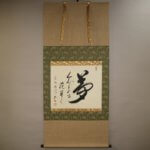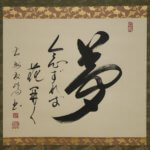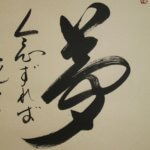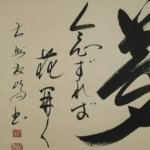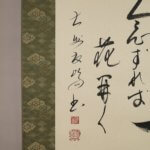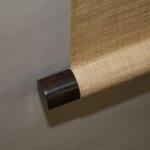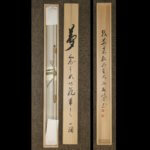Products Lineup
News / Blog
Other Menus
Kakejiku Hanging Scroll: Calligraphy: Dream & If Believes in, It Blooms / Takahashi Yūhō - Yume / Nenzureba Hanahiraku
- Product ID
- 0278
- Name
- Takahashi Yūhō
- Profile
The chief priest at the Daianzen-ji temple in Fukui pref.
1948
Born in Fukui city, Japan
1970
Graduated from the Kyoto Hanazono University (Major: Buddhism)
Joined and practiced asceticism at the Kaisei-ji temple in Hyogo for 6 years1989
Appointed as the chief priest at the Daianzen-ji temple in Fukui
2008
Exhibition at the Takumi museum in JR Gifu Station
Exhibition at the art gallery in Inoue department in Nagano2011
Opened a gallery in the Daianzen-ji temple
Also appointed as the chief priest at the Housyou-ji temple in Ishikawa
Exhibition at the “Gallery Metanoia” in Paris, France2014
Performed at the Sarah Lawrence College in NY, USA
- Size
- 690mm x 1410mm
- Roller End Material
Red sandalwood- Material of the Work
- Japanese paper
- Stock Condition
- Sold out
- Description
Sakamura Shinmin (1909-2006) was a poet from Kumamoto Prefecture. His heart-warming poems, many of which are easy to understand, have been loved by everyone from elementary school children to businessmen. “Nenzureba Hana Hiraku”, in particular, has attracted sympathy from many people, to allow the poem monument to be built all over the country and even abroad. This is a testament to the fact that the simple message, “Believe in things and devote yourself single-mindedly to them, and your dreams will come true”, has touched the hearts of people around the world.
Takahashi Yūhō, an expert calligrapher active not only in Japan but also in Europe and the United States, has put together this work with a soft, vigorous style of writing, which he hopes will be familiar to more people around the world. The character “Yume” is written in a large letter next to the word, expressing the encouragement from the Zen monk alive today, who wants to support the audience’s dreams. This is a wonderful piece of art, yielding a courage to live.



